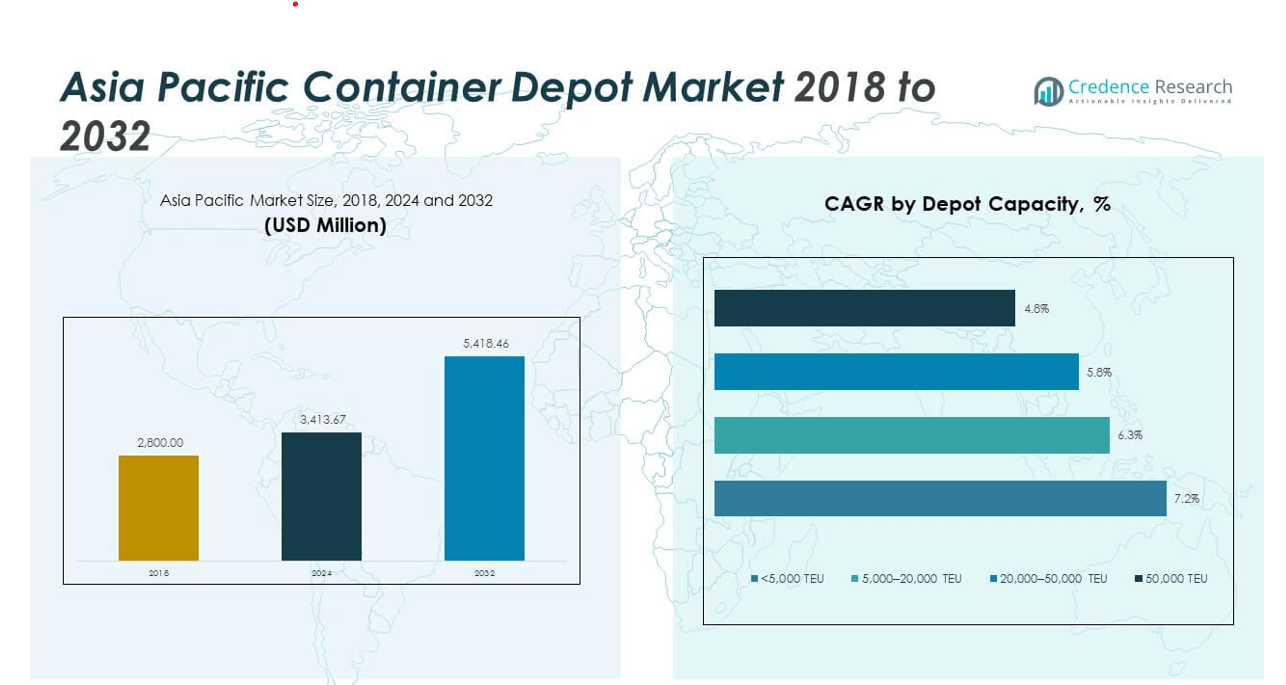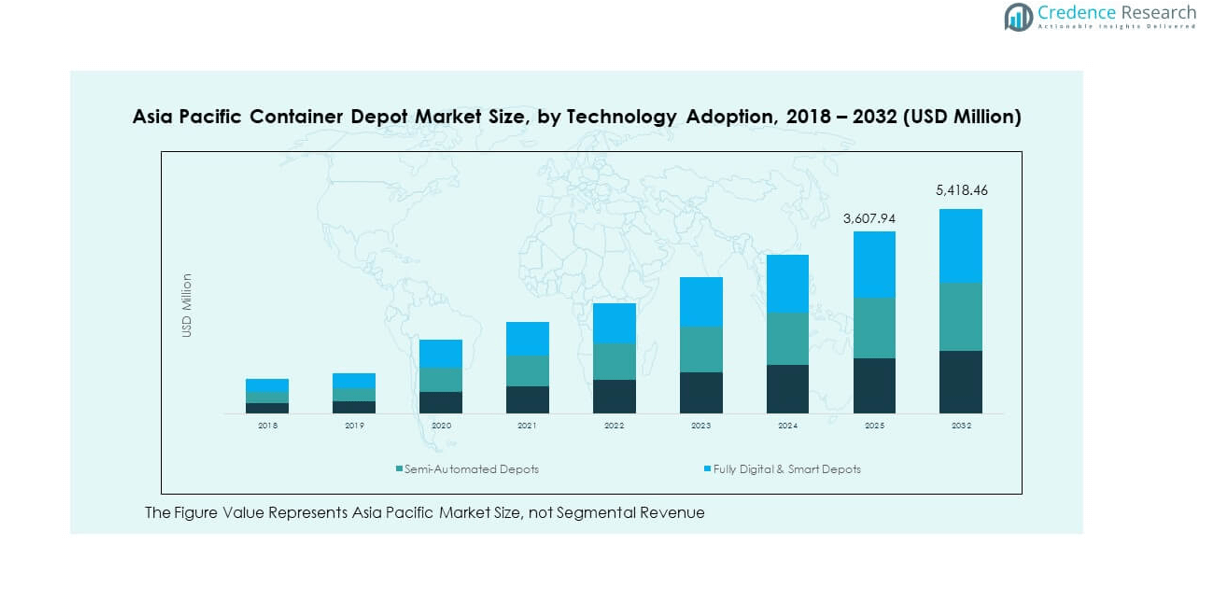CHAPTER NO. 1 : INTRODUCTION 22
1.1. Report Description 22
Purpose of the Report 22
USP & Key Offerings 22
1.2. Key Benefits for Stakeholders 23
1.3. Target Audience 23
CHAPTER NO. 2 : EXECUTIVE SUMMARY 24
CHAPTER NO. 3 : ASIA PACIFIC CONTAINER DEPOT MARKET FORCES & INDUSTRY PULSE 26
3.1. Foundations of Change – Market Overview 26
3.2. Catalysts of Expansion – Key Market Drivers 28
3.3. Momentum Boosters – Growth Triggers 29
3.4. Innovation Fuel – Disruptive Technologies 29
3.5. Headwinds & Crosswinds – Market Restraints 30
3.6. Regulatory Tides – Compliance Challenges 31
3.7. Economic Frictions – Inflationary Pressures 31
3.8. Untapped Horizons – Growth Potential & Opportunities and Strategic Navigation – Industry Frameworks 32
3.9. Market Equilibrium – Porter’s Five Forces 33
3.10. Macro Forces – PESTEL Breakdown 35
CHAPTER NO. 4 : COMPETITION ANALYSIS 37
4.1. Company Market Share Analysis 37
4.1.1. Asia Pacific Container Depot Market Company Revenue Market Share 37
4.2. Strategic Developments 39
4.2.1. Acquisitions & Mergers 39
4.2.2. New Service Type Launch 40
4.2.3. Agreements & Collaborations 41
4.3. Competitive Dashboard 42
4.4. Company Assessment Metrics, 2024 43
CHAPTER NO. 5 : ASIA PACIFIC MARKET ANALYSIS, INSIGHTS & FORECAST, BY SERVICE TYPE 44
CHAPTER NO. 6 : ASIA PACIFIC MARKET ANALYSIS, INSIGHTS & FORECAST, BY DEPOT CAPACITY 49
CHAPTER NO. 7 : ASIA PACIFIC MARKET ANALYSIS, INSIGHTS & FORECAST, BY CONTAINER TYPE 53
CHAPTER NO. 8 : ASIA PACIFIC MARKET ANALYSIS, INSIGHTS & FORECAST, BY OWNERSHIP 57
CHAPTER NO. 9 : ASIA PACIFIC MARKET ANALYSIS, INSIGHTS & FORECAST, BY TECHNOLOGY ADOPTION 61
CHAPTER NO. 10 : ASIA PACIFIC MARKET ANALYSIS, INSIGHTS & FORECAST, BY COUNTRY 65
CHAPTER NO. 11 : COMPANY PROFILE 68
11.1. Eng Kong Container Services (Singapore) 68
11.2. CMA CGM Depots (Asia Network) 71
11.3. Yusen Logistics (Japan/Asia) 71
11.4. DP World (Asia) 71
11.5. Ocean Network Express (ONE) Depots 71
11.6. Company 6 71
11.7. Company 7 71
11.8. Company 8 71
11.9. Company 9 71
11.10. Company 10 71
11.11. Company 11 71
11.12. Company 12 71
11.13. Company 13 71
11.14. Company 14 71
List of Figures
FIG NO. 1. Asia Pacific Container Depot Market Revenue Share, By Service Type, 2024 & 2032 44
FIG NO. 2. Market Attractiveness Analysis, By Service Type 45
FIG NO. 3. Incremental Revenue Growth Opportunity by Service Type, 2024 – 2032 46
FIG NO. 4. Asia Pacific Container Depot Market Revenue Share, By Depot Capacity, 2024 & 2032 49
FIG NO. 5. Market Attractiveness Analysis, By Depot Capacity 50
FIG NO. 6. Incremental Revenue Growth Opportunity by Depot Capacity, 2024 – 2032 51
FIG NO. 7. Asia Pacific Container Depot Market Revenue Share, By Container Type, 2024 & 2032 53
FIG NO. 8. Market Attractiveness Analysis, By Container Type 54
FIG NO. 9. Incremental Revenue Growth Opportunity by Container Type, 2024 – 2032 55
FIG NO. 10. Asia Pacific Container Depot Market Revenue Share, By Ownership, 2024 & 2032 57
FIG NO. 11. Market Attractiveness Analysis, By Ownership 58
FIG NO. 12. Incremental Revenue Growth Opportunity by Ownership, 2024 – 2032 59
FIG NO. 13. Asia Pacific Container Depot Market Revenue Share, By Technology Adoption, 2024 & 2032 61
FIG NO. 14. Market Attractiveness Analysis, By Technology Adoption 62
FIG NO. 15. Incremental Revenue Growth Opportunity by Technology Adoption, 2024 – 2032 63
FIG NO. 16. Asia Pacific Container Depot Market Revenue Share, By Country, 2024 & 2032 65
List of Tables
TABLE NO. 1. : Asia Pacific Container Depot Market Revenue, By Service Type, 2018 – 2024 (USD Million) 47
TABLE NO. 2. : Asia Pacific Container Depot Market Revenue, By Service Type, 2025 – 2032 (USD Million) 48
TABLE NO. 3. : Asia Pacific Container Depot Market Revenue, By Depot Capacity, 2018 – 2024 (USD Million) 52
TABLE NO. 4. : Asia Pacific Container Depot Market Revenue, By Depot Capacity, 2025 – 2032 (USD Million) 52
TABLE NO. 5. : Asia Pacific Container Depot Market Revenue, By Container Type, 2018 – 2024 (USD Million) 56
TABLE NO. 6. : Asia Pacific Container Depot Market Revenue, By Container Type, 2025 – 2032 (USD Million) 56
TABLE NO. 7. : Asia Pacific Container Depot Market Revenue, By Ownership, 2018 – 2024 (USD Million) 60
TABLE NO. 8. : Asia Pacific Container Depot Market Revenue, By Ownership, 2025 – 2032 (USD Million) 60
TABLE NO. 9. : Asia Pacific Container Depot Market Revenue, By Technology Adoption, 2018 – 2024 (USD Million) 64
TABLE NO. 10. : Asia Pacific Container Depot Market Revenue, By Technology Adoption, 2025 – 2032 (USD Million) 64
TABLE NO. 11. : Asia Pacific Asia Pacific Container Depot Market Revenue, By Country, 2018 – 2024 (USD Million) 66
TABLE NO. 12. : Asia Pacific Asia Pacific Container Depot Market Revenue, By Country, 2025– 2032 (USD Million) 67










